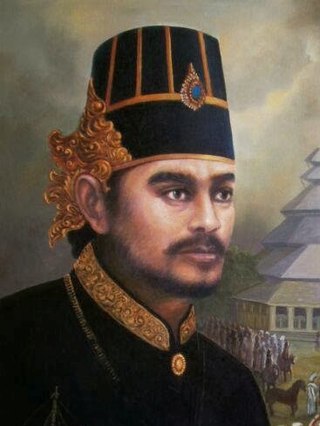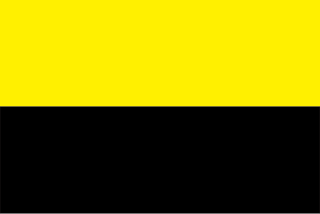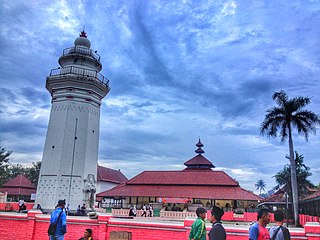
Banten is the westernmost province on the island of Java, Indonesia. Its capital city is Serang. The province borders West Java and the Special Capital Region of Jakarta on the east, the Java Sea on the north, the Indian Ocean on the south, and the Sunda Strait on the west. The province covers an area of 9,662.82 km2 (3,730.84 sq mi). It had a population of over 11.9 million in the 2020 census, up from about 10.6 million in 2010. The estimated mid-2022 population was 12.25 million. Formerly part of the province of West Java, Banten was declared a separate province in 2000. The region is the homeland of the Bantenese people, whose culture differs slightly from that of West Java's Sundanese people. The northern half has recently experienced rapid rises in population and urbanization, and the southern half has a more traditional character but an equally fast-rising population.
Sunan Gunungjati (1448–1568) was one of the Wali Songo, or nine saints of Islam revered in Indonesia. He founded the Sultanate of Banten, as well as the Sultanate of Cirebon on the north coast of Java.

The Banten Sultanate was a Bantenese Islamic trading kingdom founded in the 16th century and centred in Banten, a port city on the northwest coast of Java; the contemporary English name of both was Bantam. It is said to have been founded by Sunan Gunungjati, who had previously founded Cirebon.

Maulana Hasanuddin was a ruler of the Banten Sultanate from c. 1552 to 1570. Hasanuddin was a Azmatkhani Ba 'Alawi Sayyid, the son of Sunan Gunungjati and Nyai Ratu Kawunganten.

Sultan Abu al-Mafakhir Mahmud Abdulkadir or better known as Pangeran Ratu was the ruler of Banten in Northwest Java, Indonesia, and was the first ruler anywhere on the island of Java to take the title of sultan, which he took in 1638, under the Arabic name Abu al-Mafakhir Mahmud Abdulkadir. This set a precedent for Sultan Agung of Mataram soon afterwards to take the title himself.
The Sultanate of Sambas was a traditional Malay state on the Western coast of the island of Borneo, in modern-day Indonesia.

The Bantenese people are an indigenous ethnic group native to Banten in the westernmost part of Java island, Indonesia. The area of Banten province corresponds more or less with the area of the former Banten Sultanate, a Bantenese nation state that preceded Indonesia. In his book "The Sultanate of Banten", Guillot Claude writes on page 35: “These estates, owned by the Bantenese of Chinese descent, were concentrated around the village of Kelapadua.” Most of Bantenese are Sunni Muslim. The Bantenese speak the Bantenese language, a variety of the Sundanese language which does not have a general linguistic register, this language is called Basa Sunda Banten.

The Sultanate of Cirebon was an Islamic sultanate in West Java founded in the 15th century. It is said to have been founded by Sunan Gunungjati, as marked by his letter proclaiming Cirebon's independence from Pajajaran in 1482, although the settlement and the polity had been established earlier, in 1445. Sunan Gunungjati also established the Sultanate of Banten. It was one of the earliest Islamic states established in Java, along with the Sultanate of Demak.

Sultanate of Banjar or Sultanate of Banjarmasin was a sultanate located in what is today the South Kalimantan Province of Indonesia. For most of its history, its capital was at Banjarmasin.
Sultan Syarif Abdurrahman Alkadrie or Syarif Abdul Rahman Al Qadri 23 October 1771 – 28 February 1808 was the founder and the first Sultan of Pontianak. He was born in 1729/1730, and was the son of Syarif Habib Husein bin Ahmad Al Qadri, an Arab preacher and propagator of Islamic teachings. His mother was Nyai Tua Utin Kabanat, daughter of Sultan Muhammad Muazzuddin of Matan.

Great Mosque of Banten is a historic mosque in Old Banten, 10 km north of Serang, Indonesia. The 16th-century mosque was one of the few surviving remnants of what used to be the port city of Banten, the most prosperous trading center in the Indonesian archipelago after the fall of Demak Sultanate in mid-16th century.

The Kraton Kacirebonan is the oldest Kraton in the Indonesian city of Cirebon. It has existed since 1807. This colonial building has housed many historical relics such as Keris, Wayang puppets, war equipment, Gamelan instruments and others. Kacirebonan in the area of the District Pulasaren Pekalipan village, exactly 1 kilometer southwest of Kasepuhan Palace and approximately 500 meters south of Keraton Kanoman. Kraton Kacirebonan is positioned from north to south with a land area of about 46,500 square meters.

Ratu Bagus Hendra Bambang Wisanggeni Soerjaatmadja, M.B.A. is the 18th sultan of Banten who was crowned on December 11, 2016 with the title of Sultan Syarif Muhammad ash-Shafiuddin Azmatkhan al-Husaini.

Habib Muhammad bin Yahya or better known as the title of Prince Noto Igomo was an Indonesian scholar from Hadhramaut who became the Grand Mufti of Kutai during the reign of Sultan Aji Muhammad Alimuddin (1899-1910).

The Mempawah Kingdom, also known as the Mempawah Sultanate, was an Islamic Dayak kingdom located in a territory now known as the Mempawah Regency, West Kalimantan, Indonesia. The name Mempawah is taken from the term "Mempauh", which is the name of a tree that grows in the upper reaches of the river, also known as the Mempawah River. In its development, Mempawah became known as the name of one of the kingdoms and sultanates that developed in West Borneo. The history of Mempawah is divided into two periods, namely the Dayak kingdom based on Hindu teachings and the period of Islamic influence.













